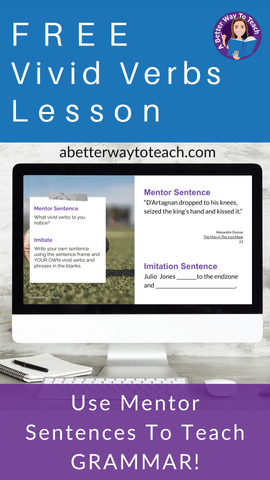Using animated short films for teens is one of my go-to strategies for instant engagement. It’s a lot of bang for your buck because animated shorts are generally only 2-7 minutes, but students LOVE them.
After spending only a few minutes watching one of these creative short films, you can ask your ELA students to do any number of things.

Why I Love Short Films In the ELA Classroom
1.) They’re super engaging
Teaching grammar is an area that is typically pretty dry for students. They’re used to worksheets and rules that seem pointless. So, if you can engage them with a creative and meaningful film, your grammar instruction will definitely go better. But that’s not the only way you can use them--I go into more detail about all the ways you can use them later in this post.
Short films are short, so they instantly draw the viewer in. Each second counts in these creative films, so they are incredibly efficient. Each scene, each gesture, each movement purposeful, so your students will be instantly drawn into the story.
If you'd like to see exactly how to use short films in your grammar instruction, grab my FREE parts of speech grammar unit. It's 7 complete resources to get you teaching grammar in a way that your students will enjoy, and will allow you to guide them toward becoming stronger writers.
2.) They encourage creativity and engage the imagination
I have a general philosophy on life that includes celebrating anything that is well done. Have you seen animated short films lately?! I mean this industry has BLOWN UP. There are so many talented creators out there, and they are killing it!
Several years ago I discovered PIXAR shorts and I thought I had found a golden goose, but I had to pay for all these films. But now, there are so many creators, so you can find dozens of extremely high-quality films on Youtube for free. And they are brilliant.
So, part of the reason I like to use these films is simply to celebrate the awesomeness of what these young creators are creating.
I also think it’s valuable to give students many opportunities for their imagination to be engaged in the classroom. Of course, this can’t happen all day every day, but it can happen regularly. So if there’s an opportunity I like to take it.
Engaging the imagination brings creativity and critical thinking. It encourages students to do good work, far better work than what they would do if they were simply told to complete a worksheet.
Engage students’ imaginations and they will be more likely to be creative themselves.
3.) You can connect these short films to SO MANY concepts
I’ll go into more detail on this in the next section, but I’ll just say for now, that you can connect animated short films to nearly anything you want to do in your classroom: story elements, theme, analysis, commentary versus summary, grammar, logos, pathos, ethos. I mean, the list is endless.
I’ll show you some practical strategies for a few of these.
How You Can Use Animated Short Films In Your Classroom
1.) Use Animated Short Films For Grammar Instruction
I use animated short films in nearly all of my grammar lessons, and here’s the reason why. It wakes students up, provides them with a writing prompt, and allows them to learn and practice in a fun but meaningful way. Here’s how I do it:
I teach a concept like vivid verbs. After I show students several mentor sentences that showcase vivid verbs, students practice writing their own sentences using vivid verbs. I’ll give them a sentence frame that is similar in structure to one of the mentor sentences we’ve discussed.
For the last part of the lesson, I don’t provide a sentence frame; I merely give students a prompt about which to write, and it’s almost always a short animated film. They watch the film, and then I ask them to write several sentences about the film focusing on their use of vivid verbs.
By giving them a prompt, they don’t have to just come up with something to write about because that would be hard for anyone. They have a topic that they understood completely about which to write. So all their energy goes toward thinking about those verbs!
I started using this technique to teach grammar several years ago and was amazed by how students excitedly wrote their sentences (and shared them) after watching these films.
If you’d like this entire lesson on verbs, I offer it FREE here.
2.) Use Them To Teach Elements of Story
Sometimes students can struggle to see elements of a story when a “short story” is 15 pages long (I’m looking at you “The Most Dangerous Game.”) But when you introduce the concept of story elements through a short film, students will more likely “get it.” Then, you can have them look for those same elements in literature.
After watching one of the short films I suggest below, ask students:
- What is the setting? Does the setting of this film play a role in the story that is being told?
- What are all the conflicts you notice (internal and external)? What is the MAIN conflict? How can you tell?
- What is the rising action? List a few things that happen before the climax that lead to the climax.
- Do you notice any foreshadowing?
- What is the climax of the film? Why do you think that’s the climax?
- What is the falling action and resolution? Is it an open or closed resolution?
I’d encourage doing this aloud for one animated short film and then asking students to do it in pairs for a second animated short film.
After students feel confident applying these concepts to short films, you can assign a short story for them to do the same.
3.) Use Short Films To Teach Analysis
Teaching analysis can get pretty tricky pretty quickly because we often ask students to analyze a text they’ve read. If they’re not great readers they may not have the first thing needed to analyze (a thorough understanding of the text). By using short animated films, you take that part out and focus on only ONE concept--analysis.
Here’s how you can do this:
- Introduce the concepts of analysis by explaining the difference between summarizing a plot and making observations, inferences, and analysis.
- Then, watch a short animated film.
- Next, have students summarize the film briefly, either in a written format or orally.
- Then, as a class, make observations, inferences, and commentary statements about the film. Remind students that commentary is something that another person could disagree with about the text, but it should be based on what happens in the text
For the film “Mr. Indifferent” (which I describe and link to later in this article) several commentary statements would be:
- The main character is selfish and short-sighted at the beginning of the film.
- The character changes because someone needs him.
- At the end of the film, the character is more full of life which one can infer because he seeks opportunities to serve others.
Again, once students feel confident with the difference between summarizing and offering commentary/analysis, you can move on to applying the same ideas to literature.
3 Films I Love To Use In The ELA Classroom
Mr. Indifferent By Aryasb Feiz
I mentioned this film earlier when talking about analysis, but I actually LOVE using it when teaching active and passive voice because the main character in the film goes from being a passive person to being an active person--and it’s endearing and awesome.
After teaching active and passive voice, I ask students to write several sentences about the film in active voice. They must circle their subject and underline the verb to check that the subject is actually the one perfomring the action. Then, I ask them to write a sentence using the passive voice, to be sure they understand the difference.

Don't Croak by Daun Kim
This video is great to use for teaching adjectives or verbs; it packs a punch. Each second is entertaining.
Once students understand what adjectives are (after giving them some direct instruction), we talk about different ways to use adjectives that create more interesting sentences.
I like to ask students to write a sentence with an opening adjective (the adjective is the first word of the sentence) about the video. This creates more interesting sentences than just placing adjectives in the middle of the sentence or at the end of the sentence.
Consider:
Terrified, the frog leapt from the table.
Instead of:
The frog was terrified.
We talk about how using this unexpected sentence structure with an opening adjective leads to more fluency and more interesting writing.
Remember that teaching parts of speech and teaching grammar, in general, is far more useful if it is directly related to improving students’ writing. I have full year grammar programs which you can gain access to instantly when you join the English Teacher Vault!
Each grammar curriculum contains all the slideshows, handouts, and follow-up assignments that you need to teach grammar so that it sticks. Check out the vault here.
Recoiled by Missouri State Students
This award-winning film can be used for multiple purposes in your instruction. You could use it to discuss internal versus external conflict, theme, or analysis.
I explain the concept of theme in literature as a complete thought that can be argued. I tell students to avoid using the word “you,” in a theme statement as that can cause it to sound like a moral.
To get students to think about theme of this film, you could talk about the main conflicts that are occurring. You could discuss the characters: how would you characterize each of them? How are they affected by the words and actions of those around them?
What is one of the messages of the film or what might the creators want the viewer to consider after watching it? These types of questions can all lead to possible theme statements.
Takeaways On Using Short Films
Using short animated films is a great springboard for so many different concepts that you are already teaching in the ELA classroom because film and literature overlap in so many ways.
If you want instant access to all the lessons mentioned in this article plus over 100 more resources for teaching secondary English, check out the English Teacher Vault, and get instant access to low prep and no prep lessons for high school English!
Looking for more ways to engage your learners with film? Check out these related articles:
- 12 Short, Short Films for ELA - SmithTeaches9to12
- Short Films To Educate In Values (educationalresources.online)
- 5 Pixar Short Films to Use in Secondary ELA — Bespoke ELA: Essay Writing Tips + Lesson Plans (bespokeclassroom.com)
- 5 super cool short films your ELA students will love | Literature Daydreams
- The Role of Short Film in Education (sciencedirectassets.com)
- Teaching With Film
- Film Shorts: A Storied Approach to Literacy Development (literacyworldwide.org)
- 31 Best Wordless Videos to Teach Problem Solving - Speech Therapy Store










Leave a comment